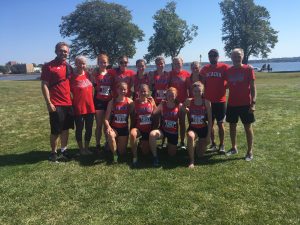This blog is about my experience spending one month with the Acadia Varsity Cross Country team training and competing. During this time I was able to give the Head Coach feedback on creating a high performance training environment.
I have known Ralph Williams for a long time and he has been a great addition to my network of coaches to discuss ideas around coaching and leadership practices.
Within the last 5 years Ralph has taken the team from a 5th place finish at the AUS championships to a 3rd place finish last year. He has done a tremendous job creating a high performance environment and keeps on striving to get better every year with the ultimate vision of winning an AUS Championships title.
This kind of attitude really attracted me to work with the team and spending volunteer hours analyzing the program and trying to find the small details that might help to improve the program even further.
I decided to take a different approach then just sitting down for coffee and talking about the training program as we usually do. We did have coffee and we decided it was time for me to integrate my self into the training environment and get first hand experience on how the team is functioning and what the culture is like.
This meant I had about 3 weeks to get back into shape to be able to keep up with the varsity women. I’m not going to lie but for the first workout I joined them at the beginning of the school year I found my self being nervous not knowing if I could keep up in the 6km time trial that was on last years AUS championships course.
We started with a warm up running to Hennigar’s Farm which would be our venue of training for the day. During the warm up I already realized that I will get a lot of insights just by being in the group as I could hear and observe the discussions going on from what the athletes were up to without even talking directly to them. It is amazing what you can hear if you just run in a warm up and listen.
Once we got to the training venue I was introduced by Ralph as the assistant coach that would be doing part of the workouts with them and Ralph let them know that I was a former CIS Gold medalist. This of course put even more pressure on me to be able to keep up (:!!!
From the beginning on I tried to stay as passive as possible in my leadership approach because I did not want to take away from the current structure as I wanted to get to know the group better and understand the dynamics within the group. At times this was hard since I’m so used to be the coach that stands in front of the group and people will rely on my direction and leadership. So I had to learn how to be a follower and observer.
The first workout went well and I was able to keep up with the top 5 athletes. During the first week I continued to train with the group 2 more times before heading to the first competition. At the competition I started acting a little bit more in a coaching role giving advice on race tactics etc. Unfortunately a lot of the runner did not as well as expected and Ralph and I had some discussions around on how to improve on that.
Because I was with the group in the warm up and cool downs and some of the workouts I was able to give Ralph some very specific feedback such as intensity of the warm up and duration of cool downs that in my view were no at the best level. Ralph was quick to react and address the lack of intensity in the warm up and lack of duration in the cool down with the team captains and they were really receptive.
I love how Ralph was not only open to the suggestions I made but right away acted on it. One of the great traits of a coach is being able to take criticism and leave the ego out of it and make the necessary adjustments to make the team a better team.
Over the next week I focused on particular athletes to help them push themselves a bit more by running with them and coaching them on the run. Some of those athletes improved on their performance on their second meet and they gave Ralph the feedback that they felt they started to believe in themselves after having been pushed in training by me.
We are now almost 1 month into the season and only 1 month away form the championships. The athletes are starting to get tired and we had to make some adjustments to the program. However Ralph always makes sure to give the athletes the right amount of challenge without overtraining them and he uses my feedback as part of his planning approach.
I’m really excited about this project not only because I’m getting into better shape but also because I truly feel I’m making a difference in how this team trains and behaves by giving the Head Coach constant feedback on intensity and group dynamics.
I’m looking forward to the next month and see what the AXEwomen can do at the AUS and U Sport Championships.
Coach Ueli

